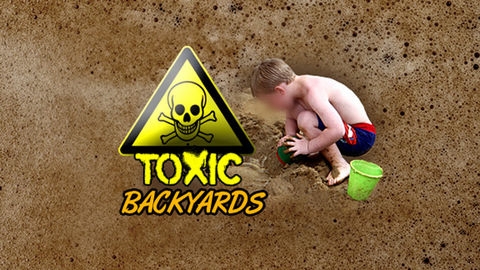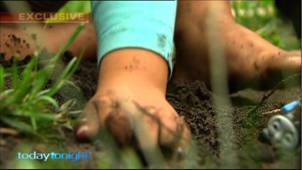|
PDF of this file
7
News
Dangers
in our soil
March 5, 2013, 6:18 pm Laura Sparkes
Today Tonight
The health of as many as 100,000
children under the age of five is under threat from lead pollution,
linked to intellectual and behavioural problems.
Health
Read more about
Macquarie
University
Professor
Mark Taylor
Mark
P. Taylor
Professor
Taylor
Children love playing in the dirt,
but their games can have dangerous consequences.
The legacy of leaded petrol has put
our most vulnerable at risk, with tests proving just how toxic
Australian backyards can be.
Professor Mark Taylor is an
environmental scientist at Macquarie University, and he's deeply
worried.
"There's a risk that children
living in leaded areas will lose IQ points, will have behavioural
problems, attention problems - they have lifelong impacts,"
Professor Taylor said.
"People have described it as a
silent epidemic."
Lead in petrol was phased out more
than ten years ago, after fuelling cars since the 1920s. But Professor
Taylor says it's by no means disappeared.
More
stories from reporter Laura Sparkes
A GUIDE TO DEALING WITH SOIL THAT
MIGHT BE LEAD-CONTAMINATED
Your soil might be lead-contaminated
if it is now or was once surrounding or nearby:
-
A pre-1997 painted residential
building or pre-2010 painted industrial building, and the paint has
deteriorated or been dry-scraped, heat-gunned or dry-sanded and
allowed to contaminate the yard;
-
Older inner city homes - pre-2002
leaded petrol vehicle emissions emitted lead particulates to the
atmosphere that accumulate in dusts, soils and ceilings;
-
A lead mine, lead smelter, lead
flashing or lead acid battery, etc, manufacturing or recycling
plant, or a waste dump/landfill, or tailings dam.
Actions to prevent lead exposure
from lead-contaminated soil:
If you are concerned, then before
buying or renting a home, and before building a vegetable garden or
chicken run, get the soil tested at a NATA
accredited laboratory. Do the same for pre-1997 house paint,
pre-2002 ceiling dust and all rainwater tanks where present. Where your
results are adverse, take measures to stop ingestion of
lead-contaminated soil, vegetables, herbs, eggs, chickens, rainwater,
etc;
-
Soil, water, household dust etc
sample test kits and instructions are available for purchase from The
LEAD Group charity.
-
If pregnant women or young
children / pets are already living in the home, or if anyone is
already drinking rainwater or eating home produce, and you are
concerned you can ask your doctor / vet for a blood lead test.
-
National Health and Medical
Research information on lead in humans is available
online. NSW Government advice on managing lead exposures is also
available online here
- that is “Lead, Your Health & the Environment”, and
following factsheets and booklets in The
LEAD Group's factsheet index.
The following lead exposure
prevention tips are suggested if lead is a concern in your environment:
-
Remove shoes at the door and use
a commercial-quality outside door mat to reduce track-in. Feet
should be wiped at least twice on the door mat.
-
Purchase a High-Efficiency
Particulate Air (HEPA) filter vacuum or safely remove pre-wetted
carpets and rugs to avoid the need for vacuuming altogether if
possible.
-
Vacuum rugs, mats and carpets and
damp mop floors once a week (twice a week if there are toddlers in
the home). Vacuum each section of carpet at least four times.
-
Do NOT vacuum hard surfaces (it
redistributes dust).
-
Clean window frames, windowsills,
and other surfaces weekly. Use a mop or sponge with warm water and a
general all-purpose cleaner or a cleaner made specifically for lead.
-
Thoroughly rinse sponges and mop
heads after cleaning dirty or dusty areas.
-
Inspect the vacuum belt and bag
monthly. Change bag when it is less than full.
-
Cleaning surfaces below 1.5
metres that small children may put their mouths on, including but
not limited to wall corners, doors, stairs, railings, windows,
baseboards, and chair rails and parts of windows (with sills below
1.5 metres) that move or touch moving parts (once a month).
-
Keep toddlers away from
remodelling areas, peeling paint, foundation soil under house eaves,
and window wells.
-
Keep play areas clean. Wash
bottles, pacifiers, toys, and stuffed animals regularly.
-
Lay down a clean sheet before
putting a baby on a carpet.
-
Keep children clean. Ensure that
children wash before they eat. Wash toddlers' hands often.
-
Protect food from settled dust by
covering and/or washing.
-
When remodelling, seal off the
work area and avoid tracking dust from remodelled area.
-
Cover bare soil in gardens and
areas beside house with wood chips or mulch.
-
Grow grass where soil is bare, or
place wood chips or mulch on bare soil.
-
Make sure children eat regular
nutritious meals, since more lead is absorbed on an empty stomach.
Make sure children's diets contain plenty of iron and calcium:
Examples of foods high in iron are liver, fortified cereal, cooked
beans, spinach, and raisins. Examples of foods high in calcium are
milk, yogurt, cheese, and cooked greens.
-
Have children wash their hands
after playing outside, and before meals, naps and at bedtime.
-
Regularly wash children's toys.
Toys can become contaminated from household dust or exterior soil.
-
Keep pets outside. If allowed
inside, brush fur outside and clean all dirt from paws.
-
Clean up paint chips immediately,
with a wet cloth or wet paper towel.
-
Prevent children from playing in
bare soil; if possible, provide them with sandboxes filled with
clean and tested sand – available from hardware stores. If using a
sandbox, parents should also cover the box when not in use.
-
Do not remove lead-based paint
yourself. It is extremely hazardous.
-
If soils are contaminated, avoid
growing leafy and root vegetables. Used raised garden beds with
clean brought-in soil for growing food plants.
-
If soils are contaminated, wear
gloves when handling soil and wash gardening clothes separately from
regular wash. Avoid bringing soil into the house.
In the event that a resident has a
high blood lead level, a more aggressive approach may be warranted,
which may include: removing ceiling dust, removing or covering
contaminated soil around the home, stabilising flaking lead-based
paints, cleaning or replacing carpets, cleaning soft furnishings.
-
To permanently remove lead
hazards, you must hire a certified lead "abatement"
contractor. Abatement (or permanent hazard elimination) methods
include removing, sealing, or enclosing lead-based paint with
special materials.
-
Always hire a person with special
training for correcting lead problems—someone who knows how to do
this work safely and has the proper equipment to clean up
thoroughly. Certified contractors will employ qualified workers and
follow strict safety rules – see www.painters.edu.au
Contact details
-
Professor Mark P. Taylor, Faculty
of Science, Macquarie University - www.envsci.mq.edu.au
-
The National Environmental
Protection Council's report: Guideline on the Investigation Levels
for Soil and Groundwater - www.ephc.gov.au
Recent papers and reports on the
risk of lead exposure to children:
-
Eliminating childhood lead
toxicity in Australia: a call to lower the intervention level
(2012). Authors: Mark P. Taylor, Chris Winder and Bruce P. Lanphear.
Medical Journal of Australia -www.mja.com.au
-
Time to rethink blood lead goals
to reduce risk to children's health (2012). Authors: Mark P. Taylor,
Chris Winder and Bruce P. Lanphear. The Conversation - www.theconversation.edu.au
-
The Final Human Health State of
the Science Report for Lead - www.hc-sc.gc.ca
-
Risk Management Strategy for Lead
- www.hc-sc.gc.ca
-
Public Health Statement for Lead.
Agency for Toxic Substances and Disease Registry - www.atsdr.cdc.gov
-
Health Effects of Low-level Lead
Evaluation. National Toxicology Program - www.ntp.niehs.nih.gov
-
Advisory Committee On Childhood
Lead Poisoning Prevention (ACCLPP). Centers for Disease Control and
Prevention - www.cdc.gov
This reporter is on Twitter at @LauraSparkes7

OUR SOCIAL SITES
Follow us on Facebook
| Twitter | Pinterest
Coming up on Today Tonight

The toxic time-bombs in backyards
across Australia that's shocking homeowners. Are you safe?View
promo »

Dangerous soil in your home
The health of as many as 100,000
children under the age of five is under threat from lead pollution,
linked to intellectual and behavioural problems.
Latest Video
Play
Video
Dangerous
soil in your home
TODAY
TONIGHT HOME
Copyright © 2013 Yahoo!7
PDF of this file
|

